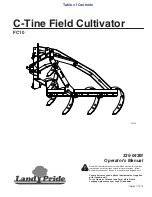
Locate the unit so that the condenser airflow is un-
restricted both above and on the sides of the unit. See
Fig. 1-5 for required clearances. The unit may be mounted
on a level pad directly on the base rails or on a raised
perimeter rail around the unit. If unit is mounted on a raised
perimeter rail, fasten the unit to the rail using the mounting
holes provided.
NOTE: Once the unit is in place, check to be sure unit is
level so that oil will equalize properly.
IMPORTANT: When placing unit modules for unit sizes
330-420, either end of module A can be placed next
to either end of module B. When placing unit mod-
ules for unit sizes 230-315, make sure modules are
placed to permit access to the control box located in
module B.
Step 2 — Join Modules A and B (230-420 Units
Only) —
If accessory trim kit has been purchased to join
the modules together, install it now. Refer to accessory in-
stallation instructions for installation details.
Step 3 — Check Compressor Mounting —
Com-
pressors are mounted on rails. Each rail is mounted on springs
(one at each end, and one between each compressor) when
applicable. For shipping, the rails are secured to the frame
base at each support. Before start-up, loosen the holddown
bolts so that the compressor rails float freely. See Fig. 9 and
10 for views of compressor mounting.
Step 4 — Cooler Fluid and Drain Piping Con-
nections —
When facing cooler side of unit, inlet (re-
turn) fluid connection is on the right. It is recommended that
a screen strainer with a minimum size of 20 mesh be in-
stalled ahead of the cooler inlet to prevent debris from dam-
aging internal tubes of cooler. Outlet (supply) fluid connec-
tion is on the left. The cooler has fluid-side Victaulic-type
connections (follow connection directions as provided by the
coupling manufacturer). If compressor and cooler grilles have
been added, holes must be cut in grilles for field piping and
insulation.
NOTE: For 130-210 and associated modular units (see
Table 1), be sure that cooler piping does not interfere with
the electrical connections.
Although cooler has an air vent, it is recommended that
field-supplied air vents be installed in system to facilitate
servicing. Field-supplied shut-off valves should also be in-
stalled to facilitate servicing and flow balancing. Locate valves
in return and supply cooler fluid lines as close to the chiller
as possible. Locate air vents at highest point of the cooler
fluid system.
IMPORTANT: Before starting unit, be sure all of the
air has been purged from the system.
Upon completion of the field piping installation, in areas
where the piping is exposed to 32 F (0° C) or lower ambient
temperatures, freeze-up protection is recommended using in-
hibited ethylene glycol or other suitable corrosion-inhibited
anti-freeze solution and electric heater tapes. Heater tapes
should have a rating for area ambient temperatures and should
be covered with a suitable thickness of closed-cell insula-
tion. Route power for the heater tapes from a separate fused
disconnect. Mount the disconnect within sight from the unit
per NEC or local codes. Label disconnect as heater tape power
source with warning that power must not be turned off ex-
cept when servicing the unit.
A drain connection is located at leaving fluid (supply) end
of cooler. See Fig. 1-4 for connection location.
PREPARATION FOR YEAR-ROUND OPERATION — If
unit is to operate all year, add sufficient inhibited ethylene
glycol or other suitable corrosion-inhibited anti-freeze so-
lution to the cooler fluid to prevent freeze-up under cold op-
erating conditions. Consult local water authority on charac-
teristics of area water and a recommended inhibitor for the
cooler fluid loop.
PREPARATION FOR WINTER SHUTDOWN — Do
not shut off control power disconnect during off-season
shutdown.
At end of cooling season:
1. If unit has optional heater tapes on cooler, remove fuse
no. 1.
Failure to remove fuse no. 1 before draining heater-
equipped coolers can result in heater tape and in-
sulation damage.
2. Drain the fluid from the system.
3. Replace the drain plug and add 2 gallons (8 liters)
(080-110 and associated modular units), 3 gallons
(11.4 liters) (130-190 and associated modular units), or
4 gallons (15.1 liters) (210 and associated modular units)
of inhibited ethylene glycol or other suitable corrosion
corrosion-inhibited anti-freeze solution to the cooler to
prevent freezing of any remaining water in system. Anti-
freeze can be added through the vent on top of cooler.
Fig. 9 — Compressor Mounting View
Fig. 10 — Compressor Mounting Bolts
27















































